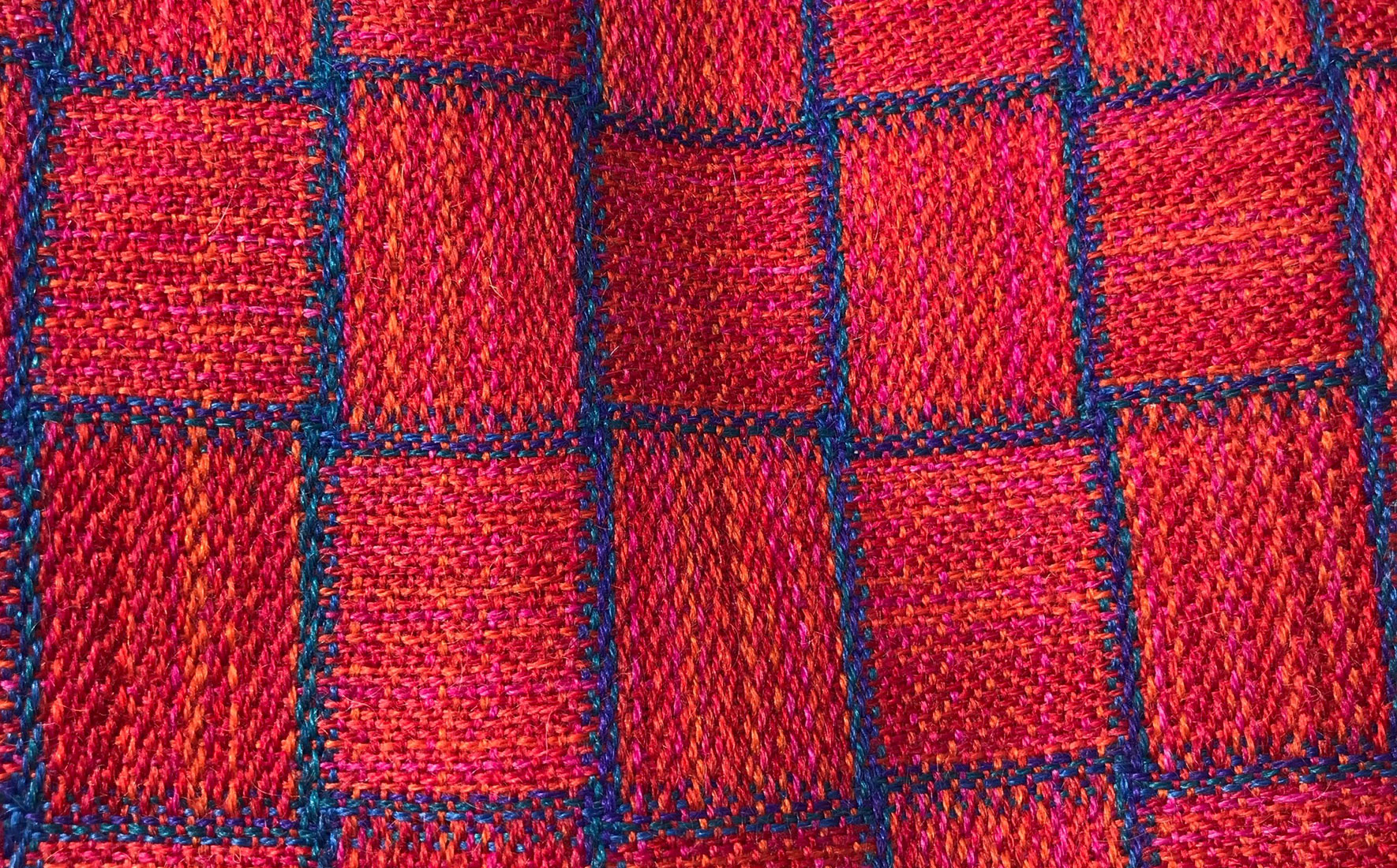
This episode tells the story of the top designer of fabrics to the French fashion industry. It looks at the way in which a modern supplier, competing in a global market, still uses ancient weaving technology with handweavers working on table looms to produce thousands of fresh designs every year.
Thanks to Eve Corrigan and the staff at Malhia Kent in Paris for showing me round and sharing their thoughts with me earlier this year.
You can find their website at https://malhia.fr/en/home/
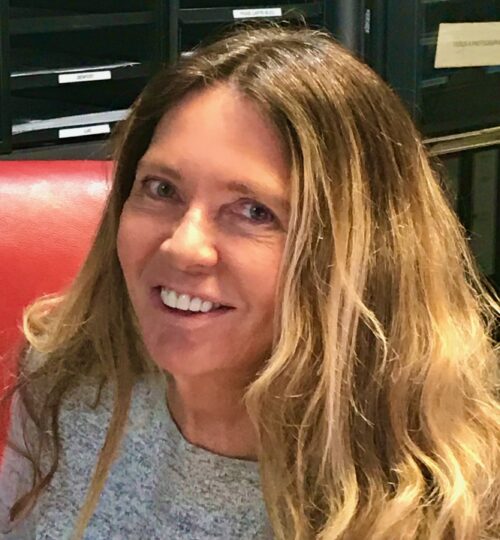
Eve Corrigan, Malhia Kent
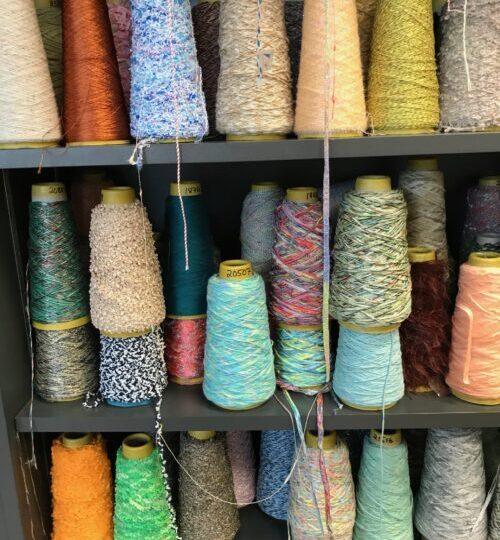
Part of Eve’s yarn stash
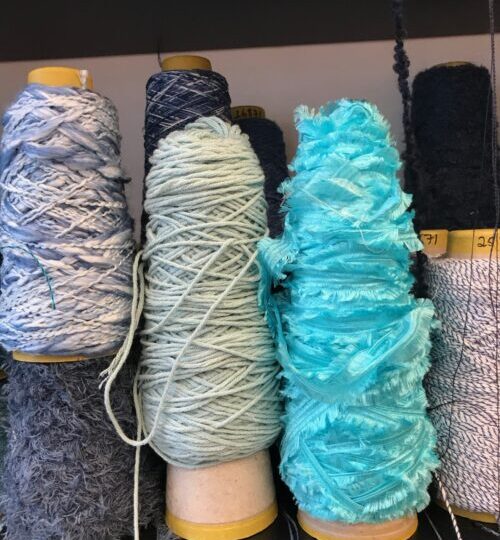
Yarn stash
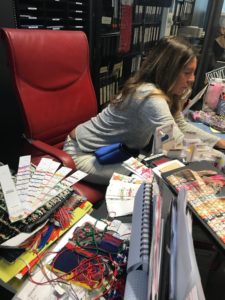
Eve Corrigan designing
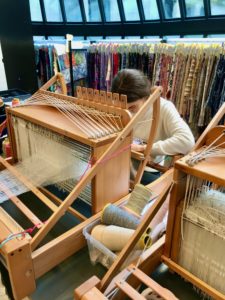
Sampling designs

Fancy yarns
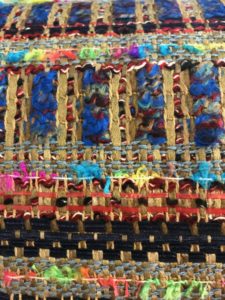
Finished fabric – Malhia Kent
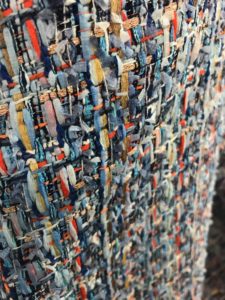
Finished Fabric

Finished Fabric
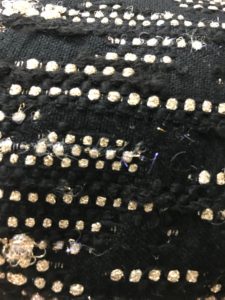
Finished Fabric
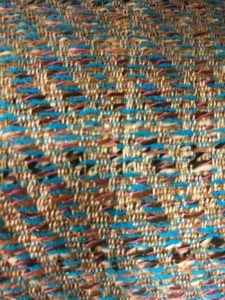
Finished fabric

Finished fabric
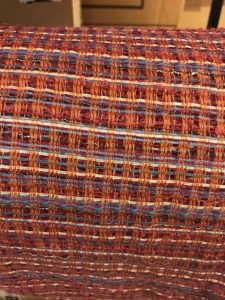
Finished Fabric
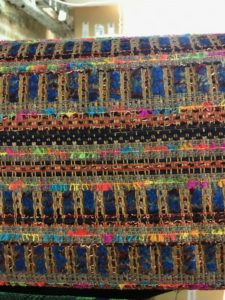
Finshed fabric
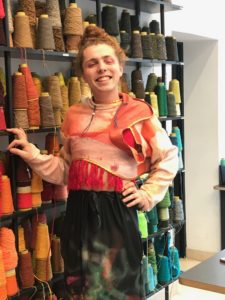
Minding the shop
Script
Yarn Yarn Yarn
There’s a small area of Paris that’s one of my favourites, it’s got an odd name – the Quinze Vignts – in English that’s the fifteen twenties. It comes from the old French system of counting which to Anglophone ears can be eccentric, so instead of saying eighty they say four twenties and for ninety, four twenties ten.
Quinze vignts is an old-fashioned way of saying three hundred, and the district is called that because it was home to a famous eye hospital that had, yes, 300 beds.
Today the Quinze-vignts is the kind of neighbourhood a film director would conjure up for his or her quintessential Paris backdrop. It has attic apartments, inventive bistros and a noisy market selling cheese, saucisson, fresh fish on slabs, fruit from across France: sunshine yellow peaches, berries in shimmery reds, sitting alongside pearly mushrooms and shiny purple aubergines. It’s a place that indulges our senses of smell and taste and just the joy of looking.
If you wander a hundred yards or so towards the main road you’ll see a shop under a railway arch that mirrors all those colours and textures – but this time we’re looking at fabric, lots of it. The windows are full of some of the most extraordinary cloth I have seen, and inside there is more, lots more, glimmering peacock jacquards, tangerine twills with purple tufts, iridescent green and black hopsack, multicoloured ribbon tweeds, slubby black and white weaves and gauzes in ice cream colours. If you are a sewer it makes your fingers itch as you think what you could make.
Around the walls are interesting yarns – elasticated paper, slippery rayon bound with angora, beaded twine, plastic coloured threads, thick silk ropes mixed with tiny feathers, fibres in every weight and colour. And yes if you are a weaver or a knitter it makes your fingers itch as you think what you could make.
This feast of colour and texture is called Malhia Kent, everything in the shop is for sale, at knock down prices. It is the remaindered fabric and yarns that were designed and created for French couture. These are the weaves and colours of past seasons in an industry where what is in and what is out moves fast.
Eve Corrigan
I put all the money I had on, on buying yarns. We have more than 900 tons of yarns of fancy yarns. We have the biggest collection in the world, of fancy yarns.
That’s Eve Corrigan who is the President and head designer of Malhia Kent – She is the owner of the world’s largest yarn stash and one of the top suppliers of woven fabrics to the fashion industry. The firm is successful, but she runs something that is much more than a purely commercial enterprise – it is a labour of love in a company that Eve bought for just one Euro and which turns out over thousands of new fabric designs every year.
Welcome to Haptic and Hue’s first series of podcasts, which looks at textiles of all kinds down the centuries and thinks about the role they play in our lives. I’m Jo Andrews and I’m a handweaver and a broadcaster. Haptic means the feel of something and Hue describes the pure spectrum colours.
This episode continues the exploration of the hidden hands behind the French fashion industry and this time it looks at how it has fostered some of the world’s most inventive woven fabric design. It also thinks about the way this has evolved and how it has survived and developed in the face of modern tastes and pressures.
To make it I went to Paris in March and visited workshops and ateliers, talked to designers, weavers and specialist shop owners. I didn’t know it at the time but it was a privilege to be able to do this face to face.
This story begins with Coco Chanel in 1961. At this stage Chanel was in the last flourish of her long career. She had come out of exile in Switzerland some years before after narrowly avoiding prosecution for collaboration in the Second World War and against the odds, re-opened her business in Paris. Unexpectedly it had been a success and her well-tailored casual clothing had been heralded as a new blend of fashion and youthfulness, after the cinched waists, heavy skirts and stiff jackets of Dior’s New Look.
Enter an unlikely figure of a young law student called Michele Sorano, who had bought a small handloom and taken up weaving as a hobby, a hobby that was beginning to take over her life.
Eve
And she went to Chanel and she said, I want to see Mademoiselle Chanel. Of course they said, Oh, you’re very nice. But, uh, what, what for? I said, she said, I’ve I have some fabrics that I want to show her. I said, no, leave the fabrics. And we call you back. I said, and she, she had a very hot personality and a strong, and she said, no, no, no, no, no, no. I’m not going to leave everything. I want to see Mrs. Chanel, please. And so loud that Coco Chanel heard and came down the, uh, the stairs, you know, you know, the big one and say, Oh, is this girl screaming? And she went, Oh, I’m sorry. She wants to do show you fabrics., let her come. And then she hired her
In fact Madam Chanel gave Michele Sorano an impossible task. She placed an order with the young woman for a significant amount of fabric for the next day. Amazingly Michele Sorano managed to fulfil it and as a result she and Coco Chanel established a working partnership with the House of Chanel that lasted for decades. When we think of Chanel’s trademark in the 1960s and 70’s what we are thinking of is very largely Michele Sorano’s work. She was responsible for the fantasy tweeds in strong colours and striking combinations that looked fresh and modern season after season. There was an understanding of colour and weave design in dress fabrics that became Chanel’s global hallmark.
In 1987 Michele Sorano set up Malhia Kent as an independent design house and began supplying not just Chanel but also Yves St Laurent, Christian LaCroix, Armani, Lanvin and all the big names of European Fashion. But she didn’t have long to enjoy her success:
Eve
after five years, she, she got sick and she didn’t want to, to have a treatment. So, uh, she knew that she had to find somebody to take care of, because this was her baby. She had no children, it was her baby.
Lots of people wanted to buy the company but Michele Sorano didn’t like them – they thought of Malhia Kent as a commercial proposition – she wanted something different.
At this stage Eve Corrigan was a young mother, a successful former model, she had some experience with the pret a porter industry designing and supplying garments to Paris dress shops and just as she was preparing a large lunch she got a call from her lawyer.
Eve
My lawyer called me and he said, you have to, you have to come. Now! I said, I’m sorry, but I have 14 people having lunch today. It’s 12 o’clock they’re coming. It’s not a good thing. The lawyer told me, it’s not a question. It’s order, your life is in front of me.
She deserted her guests and her lunch table and did as the lawyer told her. At the office she met Michele Sorano, who asked her
Eve
And she looked at me and she, she spoke a few things and she told me, uh, do you know how to weave? Wow, the question was hard. I said, I must say, I’m sorry, but not at all. I have no idea what is loom is and yarns. And I know fabrics because I made some garments but I know nothing about weaving, She said, okay, you’re the one! I said, can I ask you why?
it’s, because you’re going to have your creativity, before, the technique, because all the other ones, they are stopped by the technique. So they are not creative. And you will do the opposite.
So she said, that’s, that’s the way I was. And I didn’t learn. I just put creativity first and technique after. So it’s you
She offered Eve an unbelievable deal: Eve was to buy the company for €1 and Michele Sorano would design the first collection in return for 5% of the profits, so that Eve could learn the ropes. Eve set about modernising the technical side of the business and moving everything from paper records onto computers and left Michele Sorano to the creative side.
There was – though – just one catch. Eve didn’t know that Michele Sorano was sick.
Eve
After three months they called me from the hospital and say, now we have to tell you she’s at the end. So I’m sorry, but she wouldn’t make this collection.
The showing of the new season’s fabric – called the Premier Vision – was not far away
Eve
It was like a week before the premier vision So I went to, to the, to the, to the factory with no idea of what it was even a number metric. I didn’t know what it was. Okay.
But I look at the most fancy yarns and try to, I said, I have nothing to lose because any way I’m going to close tomorrow.
Eve may not have understood the technical process of weaving but what she did have was a real feel for colour and importantly an instinctive sense for what she wants to see in a fabric. Instead of starting with plain yarn she started with the most outlandish and complex yarns she could find. She prepared to celebrate her failure with a table at Maison Caviar
Eve
I called my mother and said, you know, it was five days from the viewing at the time. And I said, uh, Tuesday night book a table at the Maison Caviar, I’ll get drunk with vodka. I don’t drink at all because I’m going to be so ashamed of showing what I’m showing, because it’s so eccentric that everybody’s going to laugh at me. So I will close the place and not finish the premier vision salon and stop, I paid one Euro it’s okay, I learned things. Okay.
But it didn’t turn out like that – in fact her stand wasn’t big enough.
Eve
It was such a success that people were fighting because the stand was not so big. They would bring tables to put in the, in the corridors Valentino didn’t want to see Armani, So we have to put some fabrics between two, because they didn’t want to, to know which one was taking what. It was incredibly successful. The problem is that I was not organized to have so many orders, so I went to the Maison Caviar with my mother, but I had water. (Everyone laughs)
When I went to the design studio in March, in one of those perfect 19th century French villas on the outskirts of Paris, it was humming. For more than 20 years Malhia Kent – under Eve’s direction – has been at the forefront of the French fashion industry supplying fabric to both Haute Couture and Pret a Porter.
They still have a close relationship with Chanel and a special confidential desk in the design studio where they work specifically on fabric for that house.
But amazingly every year Mahlia Kent comes up with over 4,000 new designs, and this is part of the secret of their success, they work closely with clients to vary fabrics by colour or structure and they are prepared to do runs of any size from 15 metres to thousands of metres.
And if you think this is a story of mechanisation and giant machines in a modern world – that’s not the case. At the heart of this successful enterprise is still the humble hand loom and the craft of handweaving.
The design studio at Malhia Kent is a big light room with a bank of table looms. They are New Zealand Ashford looms – the kind that many beginners start their weaving journeys on. These are versatile 12 and 16 shaft looms but the weavers are warping them and weaving on them by hand to produce the 1000’s of samples that the company considers for its collections every year.
Alice
I am using different structures, we play with plain weave, twill, every basic structure, but we also try new ones, so I’m trying new ones but sometimes when you draw something you think it’s going to work and you have to try it again until it really works.
Alice is one of the weave designers, it’s her first job after completing her training at the Brussels School of Fine Art.
Alice
So this manuals and looms, so it is one of the more ancient ways of weaving. 6.10, what its good is that when you use manual looms you can try out very different combinations, before sending them to industry, because when you are weaving by hand you are more free to do new stuff and when you are in the computer you can be stuck, this weaving loom is very traditional, yes 16 shafts. So that means that we do the structure with 16 yarns, that we repeat all over the length of the fabric.
Every single sample passes under Eve’s eye. She knows what she wants and how the collection should look, and to make sure it’s right she also designs and has her yarns coloured to precise specifications. As she says: “this pink is not that pink and this green is not that green.”
It gives the fabric a look and a feel which is unlike anything else I have seen and makes them hard to copy.
Once she is happy the order passes to the big mechanised mills in the French city of Lyons where they run off thousands of metres if that is what is needed and then it is checked carefully and distributed.
Last time on this podcast we heard that a number of French couture houses now outsource some of their fine embroidery work to artisans in India and North Africa. The same is true in the fabric industry where much of the production is now done in China. Except at Malhia Kent, where Eve made an early decision to keep everything in France.
Eve
A few years ago, I would have said that that I would be much, much more rich if I was living in China because I could make all my creativity at a smaller price, but I love my country and the savoir Faire is a French or English or European any way. And I’m I cannot take something that belongs to France and make money on it in another country. That’s against my ethic.
It was an early battle for Eve. When she took over Malhia Kent in the 1990’s she was unusual in being a woman at the head of a French fabric design company. Not long after she took over the fabric producers of France called a meeting to discuss the threat from China’s fabric factories which were gaining access to European markets. She was the only woman there out of more than 250 producers.
Eve
And they all said, what are you going to do? Uh, all of them said, uh, I am going to fired one stylist out of two. Uh, I’m going to buy not to buy any more yarns. I will use the one I have and I will take some old, um, fabrics for my old collections like this. I can have, uh, the price will be better. I said, I’m sorry, but I’m new in, in the, in the job, but you’ll never go up to this price. There’s no way.
So, rather than trying to compete directly with the Chinese manufacturers on price and quality she decided on a different strategy:
Eve
For me the only way is to do something exceptional that people will, will want it because they won’t find it anywhere else. So my, uh, my Idea, but it was difficult because there was two, 269 men, um, the same position to make, To be as cheap as possible. so I told them, I told them, no, I’m going to, I’m not going to hire three stylists on top of the two I have already, and I’m going to make some very fancy things and that they said, okay, that’s enough. Thank you very much. Okay.
Eve: And I did it, but it’s very difficult to break, to take a decision when I’m all I’m new in the, in the, in the job and all the other ones, they have a lot of experience. So it was very difficult for me to, to find this strategy that was completely against the idea of the other ones. But I did it because anyway, I like beautiful things. And then I cannot make Bad things only to make money.
And it is this strategy that until now has paid off. Malhia Kent has prioritised quality, variety and original fabric design over price. All the yarns are created in France, Italy and Britain, the design and the manufacturing is all French. The speed at which the company creates new textiles and their responsiveness to individual fashion houses means that’s it hard to copy what they do. It has had a surprising outcome. Malhia Kent now sells its fabric to Chinese fashion houses.
Eve
I will, I will put on my grave. She sold fabric in China. And that is one one of the good markets for us.
I was in Paris before Covid hit the city hard this spring. Things will have been difficult for everyone in the textile industry there from the youngest designer to the oldest manufacturers. But before that happened, Eve believed that Malhia Kent has a bright future before it, and she welcomes the prospect of an age where less is more:
Eve
We have to change. We have to buy less but better. And so I think it’s, it’s in the way people doesn’t want to buy a lot of things. They want to buy one beautiful thing instead of five piece of, of China.
We want quality. We want ethics. We want the planet to be green.
This episode of Haptic and Hue was written, narrated and edited by me, Jo Andrews. Many thanks to Eve Corrigan of Malhia Kent for sharing her passion for colour and good design with us.
You can see pictures of some of Eve’s legendary Yarn stash and some of her fabrics at www.Hapticandhue.com forward slash listen.
You can also find show notes there, where I provide a complete transcript of this podcast and a list of resources and background reading that you might enjoy. You can also sign up there to get these podcasts directly into your inbox and have a chance to win the textile related gifts that I give away with each episode. You will also find blogs and other information about textiles and Haptic and Hue there. And If you want to sign up to get these podcasts directly into your inbox then there’s a form on listen page.
Next Time we look at something completely different. The vast majority of people who listen to this podcast and who use textiles – are women. In Western and northern societies not many men work with soft materials like fabrics, yarn and thread. They are much more likely to be found working with hard materials like wood or metal. Join me next time to find out why and to talk to some of the men who have bridged the divide and are happy knitters, weavers and stitchers.
And Thanks for listening.

